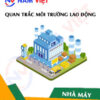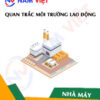Occupational Environment Monitoring at Printer Manufacturing Factory
99,000 ₫
Note: The above price is calculated per sample and may vary depending on the area of the environment to be monitored and market fluctuations. For more accurate pricing support, please refer to the price list or contact our consulting staff directly.
Monitoring the environment of a printer production factory is a session for collecting, analyzing, and evaluating workplace factors that may be harmful to workers’ health.
Table of Contents
Toggle1. Overview of Printer Factories
a. What is a printer factory?
A factory for printers is an industrial facility where printers and printing equipment are produced. Printers produced in this factory may include industrial printers for large-scale printing processes, commercial printers, or printers for personal use.
Through complex production processes and machinery, the printer factory is capable of producing a wide variety of printers, including laser printers, inkjet printers, offset printers, thermal printers, 3D printers, and many other printing technologies.

b. Production stages in a printer factory
Production stages in a printer factory can be diverse, depending on the printer type and specific production process of the factory. Below is an example of common production stages in a printer factory:
- Design and development: This stage involves research and development of printers, including creating technical drawings, developing new printing technologies, and building models and prototypes.
- Procurement and transportation: The factory purchases necessary components, parts, and materials for printer production from suppliers. These components are then transported to the factory for assembly.
- Assembly and quality inspection: Components and parts are assembled according to predefined procedures. Once the printer is fully assembled, quality inspections are conducted to ensure proper operation and compliance with quality standards.
- Testing and calibration: Printers are tested and calibrated to ensure accurate operation and meet printing requirements. This includes checking print functions, adjusting settings, and verifying compatibility with software and other systems.
- Packaging and final evaluation: After testing, printers are packaged and prepared for shipment. Final inspections are performed to ensure printers meet all standards and requirements before leaving the factory.

c. Machinery used in printer factories
Printer factories use various machinery and equipment to perform production and assembly processes. Some common types of machinery include:
- Metal cutting and processing machines: Used to cut and process metal components of printers, including metal cutters, milling machines, lathes, CNC (Computer Numerical Control) machines, and other processing equipment.
- Presses and printer frame fabrication machines: Presses are used to fabricate printer frames, working with materials such as steel, aluminum, or alloys. Presses may include hydraulic or heat presses.
- Printing and specialty printing machines: Industrial printers and specialty printers are used to print on various surfaces and materials. Common types include offset printers, flexo printers, digital printers, thermal printers, and 3D printers.
- Quality inspection equipment: To ensure final product quality, the factory uses devices such as flatness meters, sharpness testers, color meters, durability testers, and other inspection tools.
- Supporting equipment: Other supporting devices used in printer factories include sanding machines, welding machines, component assembly and configuration machines, electronic testers, printer casing assembly machines, cleaning equipment for printer parts, and more.

d. Occupational diseases for workers in printer factories
Workers in printer factories may encounter certain occupational diseases due to environmental factors and work processes. Common occupational diseases in the printer manufacturing industry include:
- Respiratory diseases: Workers may be exposed to printing dust, ink fumes, and chemical compounds during printing, leading to respiratory issues such as bronchitis, asthma, pneumonia, or tissue irritation and damage in the lungs.
- Skin diseases: Contact with chemicals in printing ink can cause dermatitis, skin irritation, allergies, or burns. Other chemicals like solvents or cleaning agents may also cause skin damage.
- Eye problems: Working with printers and printed products may involve exposure to strong light and ultraviolet rays, causing eye strain and fatigue. Working in low-light conditions can also result in eye strain and affect focus and vision.
- Noise: Printers and other equipment in the factory generate high noise levels, which can harm hearing, cause sleep disturbances, stress, and affect overall health.
- Movement-related diseases: Tasks in printer factories often involve repetitive motions, causing muscle strain, joint inflammation, and movement-related injuries such as wrist inflammation, hip joint issues, industrial knee injuries, and spinal problems.
To protect worker health, printer factories should implement labor protection measures such as providing personal protective equipment, improving work processes, ensuring proper ventilation, and maintaining occupational health and safety management systems. Additionally, educating and training workers on occupational health and safety is crucial to reduce the risk of occupational diseases.

e. Common printers on the market
There are many common types of printers available, including:
- Laser printers: Use laser technology to print images or text on paper. These printers are popular in offices due to high speed and quality.
- Inkjet printers: Operate by spraying ink onto paper through small nozzles, suitable for color printing and diverse documents.
- Continuous inkjet printers: Used to print barcodes, dates, or other information on surfaces such as paper, metal, or plastic, capable of high-speed continuous printing.
- Direct thermal printers: Use heat to create images directly on paper without ink, suitable for printing labels, tickets, invoices, and other applications.
- Thermal inkjet printers: Use high temperatures to spray ink onto paper, offering high resolution and the ability to print on various materials.
- UV inkjet printers: Use UV ink and light to print on surfaces. Capable of printing on paper, plastic, wood, metal, and even ceramics.

2. Overview of occupational environment monitoring services
a. What is occupational environment monitoring in printer factories?
Occupational environment monitoring (or workplace environment measurement) in printer factories involves collecting, assessing, and analyzing measurement indicators of workplace environmental factors to implement timely measures, minimize environmental hazards to worker health, and prevent occupational diseases. Occupational environment monitoring is a mandatory requirement for printer factories.
It plays a crucial role in caring for, protecting, and enhancing workers’ health because workers are the primary resource of a business and directly generate profit. Regular exposure to hazards exceeding permissible limits can adversely affect health and cause occupational diseases.
REGISTER FOR OCCUPATIONAL ENVIRONMENT MONITORING SERVICE
b. Nam Viet’s occupational environment monitoring program
Nam Viet’s occupational environment monitoring program is designed by monitoring engineers specializing in occupational safety and environmental protection. Aimed at ensuring worker health and safety, the program uses modern measurement methods to monitor air quality, water, microclimate, physical factors, dust, and more in the workplace. This program is critical for maintaining a safe working environment and protecting worker health.
Additionally, Nam Viet’s program plays an important role in researching and developing solutions to improve workplace environmental quality. With a dedicated and professional monitoring team, Nam Viet’s proprietary program is a breakthrough in occupational safety and environmental management in Vietnam.

c. Standardization in occupational environment measurement procedures
Standardization in Nam Viet’s workplace measurement procedures is critical for ensuring result quality. To guarantee accuracy and reliability, the program follows standards and standardized procedures recognized by the Ho Chi Minh City Department of Health. This ensures data collected is highly reliable for evaluating occupational environments and making informed decisions to protect worker health.
These standardized procedures also ensure measurements are conducted by highly qualified monitoring specialists with years of experience, providing managers and experts with trustworthy results from An Toàn Nam Việt for precise decision-making regarding occupational health and environmental safety.
By applying standardization in measurement procedures, Nam Viet demonstrates its commitment to ensuring a safe working environment, protecting worker health, and contributing to improving occupational safety and environmental management quality in Vietnam.
d. Reporting monitoring results for printer factories
Occupational environment monitoring results are compiled according to Form 04, Appendix III issued with Decree 44/2016/ND-CP and prepared in two copies: one sent to the enterprise contracting the monitoring service, and one retained by the organization conducting the monitoring.
The retention period for occupational environment monitoring records is indefinite, as regulated by law.

e. Frequency of occupational environment monitoring according to the law
According to Clause 2 of Article 18, Law on Occupational Safety and Hygiene 84/2015/QH13, employers must conduct occupational environment monitoring to assess harmful factors at least once a year.
f. Deadline for submitting occupational environment monitoring reports
The report must be submitted before December 31 each year. Enterprises in manufacturing facilities are required to submit monitoring results to the local Department of Health where the business is headquartered and where employees are working.
When there are changes in technology, production processes, or upgrades that may introduce new hazards to worker health, enterprises must update occupational hygiene records regarding harmful factors requiring environmental monitoring.
g. Penalties for violations of occupational environment monitoring by employers
According to Article 27 of Decree No. 12/2022/ND-CP dated January 17, 2022, regulating administrative penalties in labor, social insurance, and Vietnamese workers working abroad under contract:
- Clause 2: Fines of VND 2,000,000 – 5,000,000 for employers who do not publicly disclose monitoring results to employees at the workplace and areas under hazard management immediately after obtaining the monitoring results and hazard assessment outcomes.
- Clause 3: Fines of VND 20,000,000 – 40,000,000 for employers who fail to conduct occupational environment monitoring to control hazards affecting worker health as required by law.
- Clause 4: Fines of VND 40,000,000 – 60,000,000 for employers who collude with monitoring organizations to commit fraud in occupational environment monitoring activities without reaching the level of criminal liability.
3. Harmful Environmental Factors for Workers in Printer Manufacturing Factories
Workers in printer manufacturing factories may be exposed to the following harmful environmental factors:
- Chemicals: During printer production, chemicals such as inks, solvents, cleaning agents, and adhesives may be used. Long-term exposure to these chemicals can cause skin, eye, and respiratory irritation. Some chemicals can also harm the liver, kidneys, and nervous system.
- Dust and particulate matter: Printing processes can generate dust and airborne particles from printers and printing materials. Inhaling this dust and particles can irritate the nose, throat, and lungs, potentially causing respiratory problems.
- Noise: Printers in manufacturing factories produce high levels of noise, especially during printing and mechanical operations. Continuous and high noise levels can cause stress, hearing damage, and overall health impacts.
- Temperature and humidity: Some printer manufacturing processes may require specific temperature and humidity conditions. Excessively hot, cold, or humid environments can create discomfort and affect workers’ health.
- Radiation: Certain types of printers, especially UV printers, use ultraviolet (UV) light to dry ink quickly. Long-term exposure to UV light can harm the eyes and skin, cause burns and pigmentation, and negatively affect the nervous system.
- Smoke and toxic gases: Printing processes may generate smoke from inks and other materials. Poorly managed smoke and toxic gases can irritate the respiratory system and nervous system.
REGISTER FOR OCCUPATIONAL ENVIRONMENT MONITORING SERVICE
4. Measures to Improve the Working Environment in Printer Manufacturing Factories
To improve the working environment in printer manufacturing factories and protect employees’ health, the following measures can be applied:
- Chemical management: Use safe chemicals and minimize the use of hazardous substances. Ensure proper storage, usage, and disposal according to regulations. Provide personal protective equipment (PPE) for employees handling chemicals.
- Adjust production processes: Optimize processes to reduce exposure to dust and particles. Use dust extraction, ventilation systems, and air filtration to control airborne pollutants in the factory.
- Noise control: Apply soundproofing and insulation measures to reduce factory noise. Provide hearing protection for employees and implement measures such as shift rotation to minimize noise exposure.
- Temperature and humidity control: Ensure a comfortable working environment with properly regulated temperature and humidity. Use air conditioning and humidity control systems to maintain suitable conditions.
- Training and guidance: Provide training on occupational safety measures, proper use of PPE, chemical management, and safe work procedures.
- Inspection and maintenance: Conduct regular inspections and maintenance of machinery, ventilation systems, air filtration, and other safety equipment. This ensures optimal performance and reduces risks to employees.
- Periodically conduct occupational environment monitoring in factories, collecting and analyzing harmful factors affecting workers, and making adjustments to reduce hazards and prevent occupational diseases.
5. Benefits of Regular Monitoring in Printer Manufacturing Factories
An Toan Nam Viet provides enterprises with significant benefits when using occupational environment monitoring services in accordance with Decree 44/2016/ND – CP on managing and controlling harmful factors in the workplace affecting workers.
- Enterprises can proactively control harmful factors in workshops or factories.
- Receive advice and recommendations to minimize hazards and improve workplace quality.
- Indirectly protect human resources, the key factor in business development.
- Reduce the impact of occupational diseases on health, lowering future treatment costs.
- Improved worker health ensures product quality and maintains production output.
- Ensure compliance with labor safety laws, avoiding legal risks.
- Enhance credibility and professionalism, elevating the enterprise’s brand.
Nam Viet’s environmental monitoring service is a solution to reduce occupational disease risks, contributing to a clean and high-quality working environment.

6. Nationwide Occupational Environment Monitoring Center
Nam Viet Occupational Environment Monitoring Center is a professional unit specializing in monitoring and measuring occupational environment quality across all provinces in Viet Nam. With a team of experienced monitoring specialists, the center uses modern measuring equipment to ensure accuracy and reliability.
In addition to monitoring services, the center supports clients in planning, handling, and tracking occupational environment issues. With the motto “customer-centric,” the center prioritizes client satisfaction, meets all client needs, and commits to providing the best solutions for enterprises.
REGISTER FOR OCCUPATIONAL ENVIRONMENT MONITORING SERVICE
With investment in technology, equipment, and personnel, Nam Viet’s monitoring center has become one of the most reputable units in occupational environment monitoring in Ho Chi Minh City, with the following objectives:
- We always value our brand reputation and the quality of our services.
- We provide clients with the best and most suitable solutions.
- With a team of experienced Masters and Engineers committed to protecting the environment and benefiting enterprises.
- Clients using Nam Viet Environmental Monitoring receive professional service from experts, along with the best cost advantages.
The occupational environment monitoring process at Nam Viet includes the following steps:
- Before monitoring, we ensure all equipment is calibrated and meets legal requirements.
- Follow the occupational environment monitoring procedures as committed to the Department of Health.
- Accurately report monitoring results to employers.
- If monitoring results indicate unsafe conditions for workers, Nam Viet will assist in corrective measures, and the enterprise will:
- Implement measures to improve working conditions and minimize harmful factor impacts, preventing occupational diseases.
- Organize health check-ups to detect occupational and related diseases early for workers in unsafe environments.
- Provide compensation in kind for workers according to labor law regulations.

7. Occupational Environment Monitoring Price List
To help enterprises conduct professional and effective occupational environment monitoring, Nam Viet provides clients with a detailed price list for monitoring services that is high-quality and reasonably priced.
- Our price list provides detailed information about monitoring service costs, including transportation, measurement, analysis, and report preparation. Clients can trust the accuracy and reliability of our monitoring reports.
- We commit to offering competitive and reasonable prices while providing prompt and professional consultation for any monitoring service inquiries.
- With Nam Viet’s price list, clients can easily select service packages that suit their needs, ensuring maximum satisfaction with professional service quality.
No comments yet












Review Occupational Environment Monitoring at Printer Manufacturing Factory
There are no reviews yet.